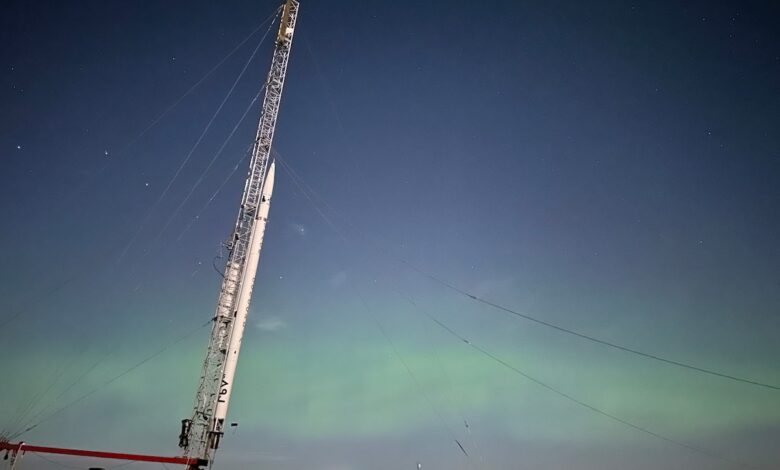Concordia University Student Rocket creates history, but falls short of achieving space

See the launch of the Rocket Starsailor student of Concordia University on Friday.
Space Concordia
For the first time this century, a rocket has built and launched in Canada to space – an attempt that was not made by a private company or government agency, but by a group of technical students at Concordia University in Montreal who turns their native dreams of space flight into the reality of space vessels for seven years.
The Rocket, Dubynchronized Starsailor, was removed on Friday at 5.34 am from an isolated launch site in the Mistissini region in Noord -Quec.
In a live stream of the event, the rocket could be seen as a ball of white light that rises quickly in a clear, early morning sky. Earlier close-ups showed the 13-meter-long cylinder attached to the support tower, which was somewhat tilted from vertically to send the rocket on a long, boog sub-orbital flight.
About eight minutes later, students on the live stream said that the rocket of the rocket was separated rather than expected than expected, around the time that the Sterrenail would have experienced maximum dynamic pressure during the flight.
Engineering students have worked on the project for seven years with Lift-off for 5:34 am et from an isolated launch site in the Mistissini region in Northern quebec.Space Concordia/Leveld
“Everyone is still pretty happy,” said Hannah Jack Halcro, an alumna and former president of the student Club Space Concordia, who commented on the live stream.
Mrs. Halcro also said that the nose cone apparently survived his short, fast journey. Once recovered, it is designed to provide detailed data on motor performance and other aspects of the flight can inform future launch attempts.
In an e -mail, team member Alice Langlois confirmed that the rocket did not reach a height of 100 kilometers, generally considered to mark the height above the earth’s surface where the space starts.
However, she said that the rocket has cleared its tower and successfully demonstrated a stable flight. “We also had excellent engine inflammation and the telemetries systems worked as intended.”
Starsailor marks the first attempt at space launch in Canada since 1998 and the first ever in Quebec. It is also the first space-launch-launched space launch to get approval from Transport Canada.
Worldwide, only a handful of student missiles has once succeeded in reaching space. Starsailor wanted to be the first to do this with the help of a liquid fuel engine, the same method with which commercial launch companies such as SpaceX regularly suffer satellites on the earth.
And although the ultimate goal of the project was not achieved during his first attempt, the fact that a student club succeeded in getting so far in a country that long ago has surrendered its ability to gain independent access, a paradigm shift.
“It’s a big problem,” said Charles Kiyanda, associate professor Engineering to Concordia. “I hope people keep an eye on this and realize that it is feasible.”
Starsailor marks the first attempt at space launch in Canada since 1998 and the first ever in Quebec. It is also the first space-launch-launched space launch to get approval from Transport Canada.Delivered
Among those who look were members of the Cree Nation of Mistissini, who approached the student team when he was looking for a sufficiently remote launch site that was accessible to the road.
“It was definitely an interesting opportunity to be part of something so unique,” said Pamela Macleod, who was the coordinator of Landbeheer and the Environment when the community agreed to participate.
Part of the attraction, she said, was to involve the youth in the community in the possibilities of space engineering. The rocket also received a Cree name, Chikabesh, which appears on the rocket in Cree Syllabics.
Together, more than 700 Concordia students were involved in the project, which started in 2018 when some members of Space Concordia decided to participate in a US $ 1 million wallet offered to the first student team that could launch a rocket in space using liquid fuel.
The competition finally folded, but the Concordia team decided to continue with the development of their original rocket design.
“We bit a lot more than we could chew, but we decided to sit down and chew with it,” said Oleg Khalimonov, who went to the project from the start and stayed with it and now worked on a master’s degree.
Mr Khalimonov said that the biggest challenge he and his teammates were confronted was learning how to build a functioning rocket motor in Canada, where there is so little expertise to guide them.
Several of their early tests ended in spectacular explosions that sent them back to the drawing board while working gradually working towards a successful design, in which the discoveries were in essence by Aerospace Engineers in the 20th century.
A turning point arrived in 2021 when, after several failures, the team was able to let its engine burn due to a volatile mixture of kerosene and liquid oxygen fuel in a controlled and reliable way that is long enough to provide a rocket with power.
“Theory can only bring you so far,” said Mr. Khalimonov prior to the launch. “If something fails, it will have failed in a way that can only be found through the flight, which I think is still a success.”
Worldwide, only a handful of student missiles once succeeded in achieving space. Starsailor wanted to be the first to do this with the help of a liquid fuel engine, the same method with which commercial launch companies such as Space X regularly suffer satellites on the earth.Delivered
In recent years, the project has been supported by donations from the Trottier Family Foundation and Engineer-Philantropist Gina Cody.
Adam Trumpour, president of Launch Canada, an organization that promotes the involvement of students at Rocketry, said that Starsailor’s stars coincide with a Groundswell of interest from university groups throughout the country who are motivated to get their own hardware in space.
“I am increasingly thinking that they are no longer satisfied to hear that, sorry, we don’t do that in Canada,” said Mr. Trumpour.
He added that escalating tensions with the United States about trade and sovereignty have led to “a seismic shift” in the discussion about whether Canada should determine the domestic launch.
If this becomes a national priority, students like those behind Friday’s launch are the key, Mr. Trumpour said: “Because they build a level of practical technical knowledge that is not really common.”



